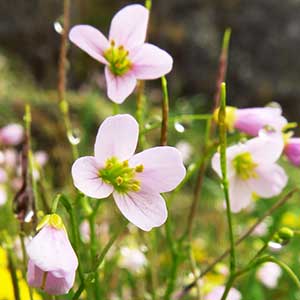Cardamine flagellifera
Cardamine pattersonii
Blue Ridge bittercress
Saddle Mountain bitter-cress
swollen, compact at stem base, (fleshy, stolons many, slender, ca. 1 mm diam., pubescent or glabrous).
cylindrical, slender, 0.5–1.5 mm diam.
erect, usually unbranched, rarely branched distally, 1–2.5 dm, sparsely to densely hirsute or pilose proximally, sparsely so or glabrous distally.
(simple from base), erect, (not flexuous), unbranched or branched basally, 0.6–3 dm.
rosulate or not, 3 or 5-foliolate, 1–6 cm, leaflets petiolulate;
petiole 0.4–2.5 cm;
lateral leaflets similar to terminal, considerably smaller;
terminal leaflet (petiolule 0.1–0.4 cm), blade obovate to orbicular or subcordate, 0.3–1.5(–2.0) cm × 2.5–16(–18) mm, base obtuse to rounded or cordate, margins entire or dentate to slightly sinuately lobed.
usually simple, rarely 3-foliolate, (3–)6–16 cm, leaflets petiolulate or subsessile;
petiole (1.5–)4–13 cm;
lateral leaflets subsessile or petiolulate (to 0.5 cm), blade similar to terminal, much smaller;
terminal leaflet (petiolule 0.5–2 cm), blade orbicular to reniform or broadly ovate, (1–)1.5–4.5 cm, base cordate, margins repand to coarsely crenate, (apiculate at vein endings, surfaces sparsely pubescent or glabrous).
2–5, 3 or 5-foliolate, petiolate, leaflets petiolulate or subsessile;
petiole 0.8–5 cm, base not auriculate;
lateral leaflets sessile or petiolulate (to 0.5 cm), blade similar to terminal, smaller;
terminal leaflet petiolulate (0.5–1.5 cm), blade broadly ovate to suborbicular, 1.5–4(–5) cm × 12–35 mm, margins repand to coarsely crenate or slightly lobed, (apiculate at vein endings, margins glabrous).
2–4, 3 or 5-foliolate, blade similar to basal, gradually reduced in size as bract, distalmost ones subtending pedicels of flowers (usually simple);
leaflet blade or bract linear to linear-oblanceolate, 0.2–0.8 cm.
ebracteate.
bracteate throughout.
sepals (ascending) oblong, 3–3.5 × 1–1.5 mm, lateral pair not saccate basally;
petals white, oblanceolate, 5–6.5(–8) × 1.5–2.5 mm, (not clawed, apex obtuse to subemarginate);
filaments: median pairs 3.5–5 mm, lateral pair 2.5–3 mm;
anthers oblong, 1.2–1.6 mm.
sepals oblong, (2–)3 × 0.7(–1) mm, lateral pair not saccate basally;
petals purple or pink, obovate, 6–9 × 3–4 mm, (not clawed);
filaments: median pairs 3–3.5 mm, lateral pair 2–2.5 mm;
anthers oblong, 0.7–1 mm.
ascending to divaricate-ascending, 7–20 mm.
divaricate-ascending, (10–)15–30(–45) mm.
linear, 1.5–2.5 cm × 1–1.2 mm;
ovules 10–14 per ovary;
style 1.2–2.5 mm.
linear, (torulose), 2–3 cm × 1–1.5 mm;
ovules 14–20 per ovary;
style 2–4 mm.
brown, oblong, 1.2–1.7 × 0.8–1.1 mm.
brown, oblong to ovoid, 1.7–2.2 × 1–1.5 mm, (winged distally).
Cardamine flagellifera
Cardamine pattersonii
Of conservation concern.
Cardamine pattersonii is known from Saddle Mountain and Onion Peak in Clastop County.
(Discussion copyrighted by Flora of North America; reprinted with permission.)
